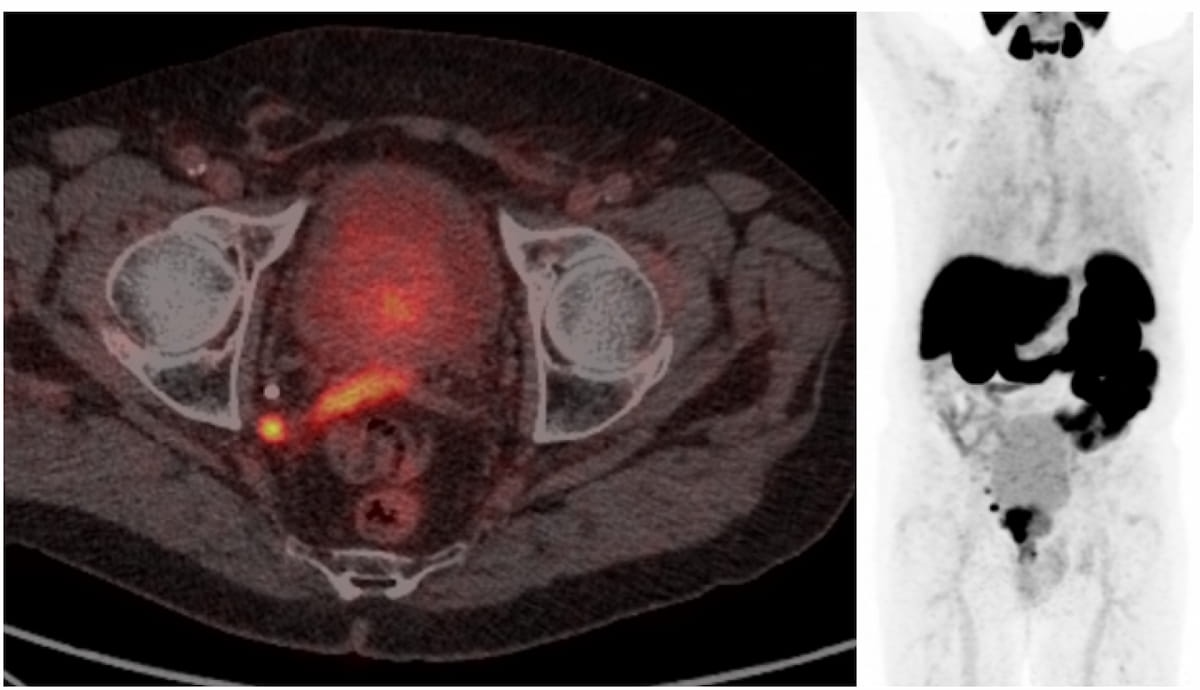ECR Study Examines Key Predictive Factors for Metastasis in Patients with High-Risk Prostate Cancer
Sixty-five percent of patients with newly diagnosed high-risk prostate cancer may have extraprostatic extension on MRI, and PSMA PET/CT findings suggest those with Gleason scores of eight or higher have more than double the risk of metastasis, according to a new study presented at the European Congress of Radiology (ECR).
New research shows that extraprostatic extension on magnetic resonance imaging (MRI), Gleason scores of eight or greater and PSA densities greater than 0.2 ng/mL2 are strongly correlated with metastatic findings on prostate specific membrane antigen (PSMA) positron emission tomography/computed tomography (PET/CT) for newly diagnosed patients with high-risk prostate cancer.
For the study, recently presented at the European Congress of Radiology, researchers examined the links between metastatic findings on PSMA PET/CT and factors such as PSA values, Gleason scores and extraprostatic extension on MRI for 97 patients (mean age of 66.6) with newly diagnosed high-risk prostate cancer. The cohort had a mean PSA of 26.1 ng/mL and mean Gleason score of eight, according to the study.
The researchers found that 63 out of the 97 patients (65 percent) had extraprostatic extension on MRI and 41.3 percent of those patients had metastatic findings on PSMA PET/CT.
Here one can see radiotracer accumulation in a metastatic pelvic sidewall lymph node and right seminal vesicle uptake (left). In addition to these findings, the maximum intensity projection (MIP) view shows radiotracer accumulation in the prostate tumor. (Images courtesy of the European Congress of Radiology.)

“The presence of (extraprostatic) spread on MRI is correlated with PSMA avid metastases and these patients should be (prioritized) for staging,” wrote Niall Sheehy, MB, MRCP, FFR, RCSI, a consultant radiologist affiliated with the Beacon Hospital in Dublin, Ireland, and colleagues.
The study authors also noted that Gleason scores of eight or higher, prostate-specific antigen (PSA) level of 10 ng/ml or higher, and PSA density greater than 0.2 ng/mL2 each more than doubled the risk of metastatic findings on PSMA PET/CT.
Specifically, 44.2 percent of patients with PSA levels 10 or higher had metastases on PSMA PET/CT in comparison to 18.5 percent of those with PSA levels 6.1-10 ng/ml. The researchers noted that 39.3 percent of those with Gleason scores eight and higher had metastases on PSMA PET/CT in contrast to 19.4 percent of patients with a Gleason score of seven. PSMA PET/CT findings also demonstrated that 38.4 percent of patients with a PSA density of > 0.2 ng/mL2 had metastases whereas 17.6 percent of those with PSA density between 0.1 and 0.2 ng/mL2 had metastases, according to the study authors.
“Our study has shown that PSMA avid nodal and osseous metastases are prevalent at the time of staging in the high-risk patient cohort. This indicates the importance of PSMA PET/CT for staging of these patients so that appropriate treatment can be offered,” emphasized Sheehy and colleagues.
Reference
1. Whiriskey RC, Doran S, Sheehy N. The utility of PSMA PET-CT in diagnosing metastatic disease in a newly diagnosed high risk prostate cancer cohort: experiences in an Irish national referral centre. Presented at the European Congress of Radiology, February 28-March 3, 2024, Vienna, Austria. https://www.myesr.org/congress/
The Reading Room Podcast: Current Perspectives on the Updated Appropriate Use Criteria for Brain PET
March 18th 2025In a new podcast, Satoshi Minoshima, M.D., Ph.D., and James Williams, Ph.D., share their insights on the recently updated appropriate use criteria for amyloid PET and tau PET in patients with mild cognitive impairment.
FDA Clears Virtually Helium-Free 1.5T MRI System from Siemens Healthineers
June 26th 2025Offering a cost- and resource-saving DryCool magnet technology, the Magnetom Flow.Ace MRI system reportedly requires 0.7 liters of liquid helium for cooling over the lifetime of the device in contrast to over 1,000 liters commonly utilized with conventional MRI platforms.
SNMMI: Can 18F-Fluciclovine PET/CT Bolster Detection of PCa Recurrence in the Prostate Bed?
June 24th 2025In an ongoing prospective study of patients with biochemical recurrence of PCa and an initial negative PSMA PET/CT, preliminary findings revealed positive 18F-fluciclovine PET/CT scans in over 54 percent of the cohort, according to a recent poster presentation at the SNMMI conference.